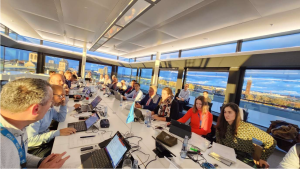News from the combined GA.COMM and GA.TeB meeting 02-2023

On 6-7 November EASA general aviation (GA) stakeholders gathered in the usual joint industry and the Member States setup to discuss topic affecting European GA. It was again a well-attended hybrid meeting organised by the GA Flightpath 2030+ team and supported by several EASA experts. It was also a good opportunity for EASA, NAAs and industry to discuss together how to ensure the proportionality of the GA regulatory environment, make the GA an incubator for aviation innovations and preserve its attractiveness for young generation.
The main points discussed were:
Natura 2000 and other environmental restrictions: The presentation by the DG ENV of the EU context of these measures provided a good overview of the situation and confirmed the need to act in a coordinated way from both perspectives - aviation, and wildlife protection. The meeting decided to further explore this dimension with aim to identify ways how the EC, EASA and all other players active in aviation and environment could work together to achieve more balanced outcomes acceptable to all.
GA Flightpath 2030+: EASA presented outline of the new internal arrangements in support of the project, the draft key topics to be focused on as well as the calendar of main events and meetings in 2024. The meeting supported the draft key topics broadly and asked EASA to develop them in a collaborative way into more concrete implementation roadmaps.
Aircraft certification: EASA presented the AMC-GM to Part-21 and invited the interested industry to engage EASA on pilot projects with aim to explore jointly this novel and a long-awaited opportunity of aircraft design approvals. The participants also received updates on ongoing discussions concerning REACH planned restrictions on unleaded AVGAS as well as sale of diesel and kerosene to private individuals, both having a potential of having a very negative impact to the existing GA.
Flight crew: Industry presented updates on well-established reduced pilot medical requirements for private flying used outside Europe (e.g., US, UK, Australia). The participants recognized possible benefits for the GA in Europe, noted ongoing discussion at ICAO and asked EASA to reflect on the presented inputs and come forward with proportionate proposals that would help to alleviate existing administrative obstacles without detriment to safety. The FAA MOSAIC program was referred to by some participants as a model for proportionality and GA “liberalisation” in the future.
Safety promotion: The participants congratulated to EASA for the safety promotions activities targeting GA including those on site like it was the case of the Grand Est Mondial Air Balloons 2023 in Chambley, France.
Air-operations: The meeting participants expressed their views on the recently published EASA Opinion 03/2023 on Innovative Air Mobility with MVCA and urged EASA to consider also the potential of existing smaller European MVCA intended for private use as incubators for innovation in this field. DGAC France then presented their views and proposals concerning cost-shared flights. These inputs will be considered for the upcoming EPAS evaluation task (EVT.0013) on more proportionate requirements for smaller commercial air transport operators. This session ended with the presentation of the issues airspace users including GA pilots face with security access at aerodromes. It was confirmed that a pan-European solution could provide for a better access for pilots along with improved physical security at all European aerodromes (i.e., regulated nationally or by EASA) when compared to the existing arrangements.
Airspace: EASA presented the latest ¡Conspicuity related developments stemming from the ongoing research project and outlined next steps for 2024. EASA aims to team up with NAAs, industry and associations in creating a coalition for promoting a wider use by the GA of ¡Conspicuity and ADS-L compliant devices. The culmination of these should be at Aero 2024 in Friedrichshafen. Then EUSPA presented the update from the recent meeting of the joint EASA and EUSPA general aviation working group, which facilitated the implementation of the first GNSS instrument approach procedures to non- instrument runways at GA aerodromes in Europe. The session concluded by EASA presentation of the existing certification scheme for flight-procedure design organisations with focus on existing flexibility for smaller entities designing simpler procedures to visual meteorological conditions minima primarily intended for GA. The meeting concluded that even a more proportionate approach would be needed to unlock the potential of such simple procedures at remaining 1500+ European aerodromes.
GA sustainability workshop: EASA presented the concept of the workshop on the GA sustainability that is planned to be held on 17 April at Aero 2024 in Friedrichshafen. The concept outline consisted of three panel discussions focusing on the different aspects – aircraft, operations, and infrastructure. The participants asked for appropriate consideration during the workshop of the need for a timely adaptation of the existing GA fleet to meet any future environmentally driven demands because that is the area where the GA community has the most concerns and interest.
The next GA combined meeting will be in-person only and will take place on 16 April at Aero 2024 in Friedrichshafen.








